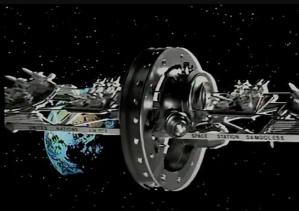Swords of Damocles
An aspect of space utilisation that has always inspired strong feelings is the concept of orbital weapons platforms [1]. The ability to launch weapons from outside Earth’s gravitational well carries clear strategic advantages, but also very real dangers. Indeed, many have compared the existence of such platforms to the ancient Roman narrative of the Sword of Damocles: a lethal weapon poised on a hair string above the eponymous Syracusian nobleman so that while he lived in luxury, he also lived in mortal fear. The uses, risks and possibilities of such platforms have been discussed in science fiction since before spaceflight first became physically possible.
Nuclear Threats
Perhaps unsurprisingly, given the intimate connection between the onset of the space age and the onset of the cold war, a common theme in science fiction of the mid-twentieth century was the fear that nuclear weapons might be located on orbital platforms. From a military perspective, these would have the advantage of improved facility security over a ground-based launch site, increased difficulty of interception, ability to deploy to any point on the planet’s surface, and independence from primary targets within national borders. From a civilian perspective, the same features rendered the prospect of hostile orbital nukes a constant and terrifying threat.
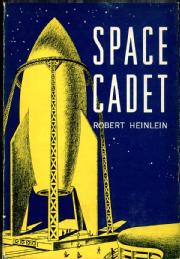 Such devices make an appearance in science fiction early in the nuclear age [2], and before even the dawn of the space age. Space Cadet, a juvenile novel by Robert Heinlein published in 1948 follows the career trajectory of a young man, Matt Dodson, in training as a space man. The Interplanetary Patrol role for which he is training is charged to maintain and operate a space-based nuclear weapons systems. This consists of a number of satellites in polar orbits, each of which can deploy nuclear bombs over any major city on Earth.
Such devices make an appearance in science fiction early in the nuclear age [2], and before even the dawn of the space age. Space Cadet, a juvenile novel by Robert Heinlein published in 1948 follows the career trajectory of a young man, Matt Dodson, in training as a space man. The Interplanetary Patrol role for which he is training is charged to maintain and operate a space-based nuclear weapons systems. This consists of a number of satellites in polar orbits, each of which can deploy nuclear bombs over any major city on Earth.
Part of Dodson’s coming of age journey is a home leave during which he clashes with his family. After a century of peace, and from the security of the mainland USA, they cannot believe that it is plausible for the North American-dominated Patrol to ever bomb the country. By contrast, young Patrol cadet Dodson knows without doubt that he and his colleagues would deploy the weapons if the circumstances required it: their duty is maintaining peace for humanity, rather than any national loyalty.
This discussion explicitly asks the question “quis custodiet ipsos custodies” - who watches the watchmen? - in its chapter title. Who gets to decide on when the weapons are deployed? A running theme in the book is the idea that a space patrol man has a duty to obey lawful orders, but also an obligation to consider and ensure that legality. In other words, Space Cadet poses the key dilemma of defensive orbital nuclear platforms: how can any state guarantee that its nuclear arms will not be turned on its own subjects by a rogue actor, independent of the nominal enemy? As it happens though, Dodson is not called to put his shifted viewpoint to the test. His training moves on and the orbital weapons platforms do not feature in the rest of the novel.
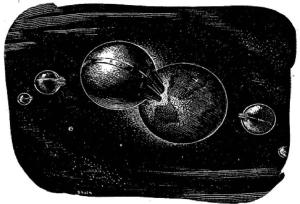 A near contemporary, and far more terrifying, story by Kris Neville appeared in Astounding Science Fiction in October 1949. Called “Cold War” it described a future scenario in which the United States chooses to invest its entire nuclear arsenal in an attempt to enforce world peace using a series of nine nuclear-armed space stations, each capable of devastating a continent. They consider this primarily a deterrent weapon since it cannot prevent an enemy first strike, but can ensure a devastating retaliation. Unfortunately the president faces an appalling dilemma: the psychological strain of service on the all-powerful space stations is irresistible. As the story notes, despite extensive testing and training: “There still remain those men upon whom the Space Stations act as a drug. Like marijuana. They seem to tower above mortality!”
A near contemporary, and far more terrifying, story by Kris Neville appeared in Astounding Science Fiction in October 1949. Called “Cold War” it described a future scenario in which the United States chooses to invest its entire nuclear arsenal in an attempt to enforce world peace using a series of nine nuclear-armed space stations, each capable of devastating a continent. They consider this primarily a deterrent weapon since it cannot prevent an enemy first strike, but can ensure a devastating retaliation. Unfortunately the president faces an appalling dilemma: the psychological strain of service on the all-powerful space stations is irresistible. As the story notes, despite extensive testing and training: “There still remain those men upon whom the Space Stations act as a drug. Like marijuana. They seem to tower above mortality!”
In other words, space station service renders men irrational and dangerously indifferent to the world below - if not actively antagonistic. This America must decide between abandoning its only defence from a world it has alienated, and sitting under a deadly time bomb that might well turn on its creators.
Despite such speculative warnings, by 1951, rocket pioneer and advocate Wehner von Braun was pushing for the United States to consider construction of a nuclear-armed orbital weapons platform, and suggested in an article that “the nation which first owns such a bomb-dropping space station might be in a position virtually to control the Earth.” As access to space became increasingly plausible into the 1960s, science fiction continued to consider its ultimate goal and whether space weapons platforms would become a reality.
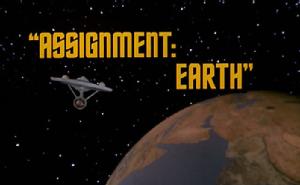 The question of whether such platforms would be to humanity’s benefit was asked in one of the more unusual episodes [3] of the original series of Star Trek (TV, 1966-1969). “Assignment Earth” (1968) involved the USS Enterprise travelling back in time to the mid-twentieth century, where it encountered Gary Seven, a mysterious individual with an agenda of his own, who appears to be interfering with the historical events of 1968. His immediate objective proves to be an attempt to destroy one of the first orbital nuclear weapons platform on launch, discouraging the further development of this technology.
The question of whether such platforms would be to humanity’s benefit was asked in one of the more unusual episodes [3] of the original series of Star Trek (TV, 1966-1969). “Assignment Earth” (1968) involved the USS Enterprise travelling back in time to the mid-twentieth century, where it encountered Gary Seven, a mysterious individual with an agenda of his own, who appears to be interfering with the historical events of 1968. His immediate objective proves to be an attempt to destroy one of the first orbital nuclear weapons platform on launch, discouraging the further development of this technology.
As characters Kirk and Spock discuss during a briefing:
Kirk: "Weren't orbital nuclear devices one of this era's greatest problems?"Spock: "Most definitely. Once the sky was full of orbiting H bombs, the slightest mistake could have brought one down by accident, setting off a nuclear holocaust."
However the attempted intervention of the Enterprise to prevent Gary Seven from acting actually proves to establish their own chronology, in which international efforts to prevent proliferation of such platforms were historical fact. As an aside, the Star Trek universe also features defensive orbital weapons platforms around other inhabited planets, notably the Cardassian homeworlds which deployed them during the Dominion War of the Star Trek: Deep Space Nine era (ST: DS9 episodes “Tears of the Prophets”, “What you Leave Behind”, 1998). These had the unusual design flaw (for a weapons station) of being dependant on an external power source, rather than internally powered, and were primarily the site for energy weapons rather than nuclear devices, but were nonetheless devastating to attacking starships.
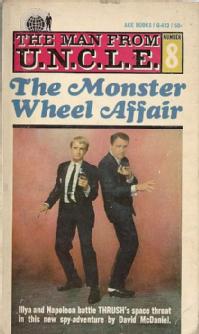 Returning to the Twentieth Century, another view also has its roots in a television series. Published in 1967, The Monster Wheel Affair by David McDaniel is a tie-in novel to the television series The Man from U.N.C.L.E. Although deeply rooted in the cold war spy thriller genre, the secret-agent series frequently featured science fiction scenarios and tropes, primarily those centred on near-future advanced technologies and weapons development. The novel in question begins with the accidental sighting of a rocket launch, soon after which a giant wheel-shaped space station is observed by ground-based telescopes. The character Alexander Waverley succinctly summarise the implied threat:
Returning to the Twentieth Century, another view also has its roots in a television series. Published in 1967, The Monster Wheel Affair by David McDaniel is a tie-in novel to the television series The Man from U.N.C.L.E. Although deeply rooted in the cold war spy thriller genre, the secret-agent series frequently featured science fiction scenarios and tropes, primarily those centred on near-future advanced technologies and weapons development. The novel in question begins with the accidental sighting of a rocket launch, soon after which a giant wheel-shaped space station is observed by ground-based telescopes. The character Alexander Waverley succinctly summarise the implied threat:
“That monstrous wheel represents possibly the greatest threat to the security of the entire world in history. Whoever controls it can control any spot on the surface of the planet except for a few thousand square miles at the poles. From such a stable platform, every major operation can be studied with relatively simple telescopes, and thermonuclear missiles can be placed with a maximum of accuracy and a minimum expenditure of energy And as long as we don’t know who controls it, we remain unable to strike back.” (UK edition, pg 63/4)
In this particular case, the threat proves to be tied not to a particular government, but to the series’ recurrent antagonist THRUSH - a consortium of organised criminal operators. However, as the characters note, this raises interesting questions regarding how such a station can be funded, constructed and deployed with the apparent rapidity seen here. Resolving those questions is key to the plot.
Moving forwards in time, the nuclear-weapons-in-space trope reappears in the 1970s children’s television series The Tomorrow People (television series, ITV, 1973-1979). This series proposes that a small number of adolescents now alive represent the next stage of human evolution, homo superior, and are gifted with both a range of psychic talents and a sense of moral responsibility for the future and safety of the race. In “The Doomsday Men” (1974), the young protagonists discover that an orbital peacekeeping platform has been subverted by a group of right wing military officers determined to prevent signing of a major all-powers disarmament treaty. This secret society, the titular Doomsday Men, aim to impose their will on the world below by threatening the world’s nations with the nuclear missiles sited on the space station for peacekeeping purposes. Here the analogy to the Damocles story is explicit: the entire space platform endeavour is known as “United Nations Space Station Damoclese” and its emblem shows a sword poised over the world. Indeed, the characters comment on the whole concept of armed peacekeeping:
John: “The Damoclese space station is one of the reasons why the peace treaty is being signed.”
Elizabeth: “It’s got nothing to do with world peace! The Damoclese project is a ridiculous idea. No one ever saved anything by threatening to destroy it.”
John: “Not only that. Imagine what would happen if a bunch of cranks like the Doomsday Men were to get hold of it!”
- The Tomorrow People - "Doomsday Men" - Episode 1
Although aimed at a young audience, and thus perhaps a little simplistic in its anti-authority, pacifist worldview, “The Doomsday Men” is interesting for its design of the space station, which includes a rapidly-spinning central section for generating centrifugal gravity, as well as a laser transmitter, docking and launching platforms for a range of missile types. Other scenes show an early space-plane/shuttle design in use as its crew shuttle, as well as vividly portraying the risk of death by asphyxiation for drifting astronauts. It’s also unusual for a 1970s near-future-set science fiction in showing a United Nations joint crew including US, UK and Chinese military personnel. Naturally the conspiracy is eventually overcome (through a nifty use of conservation of angular momentum no less!). Given the inaccessibility of the orbital platform to other interventions, the ability of the Tomorrow People to teleport into orbit is crucial to defeating the Doomsday Men’s plot.
It’s interesting to note that despite the end of the original Cold War, the idea of nuclear orbital weapon repositories as a threat have never entirely disappeared from science fiction narratives, although the idea of a single space station platform has faded over time. Instead, concern has risen over the possibility of individual, possibly autonomous nuclear devices which could hide, or be hidden, amidst space junk in the orbital environment. These present a threat to the Earth below, to other spacecraft and habitats directly, or through triggering an ablation cascade (aka Kessler syndrome) in which a chain reaction of destructive collisions saturates the orbital environment with hazardous debris. Relatively recent examples here include cases such as Ken MacLeod’s novel The Sky Road (1999) or the animated television series Thunderbirds Are Go (episode “Space Race”, 2015), and orbital weapons platforms also appear in the writing of Stephen Baxter, Ken Morden and others.
Solar Power
While nuclear weapons present a tangible and somewhat comprehensible orbital threat, the potential of orbital stations to threaten the world below has been extended in science fiction to encompass a range of other, equally terrifying, weapons technologies.
The possibility that huge mirrors in space might be used to focus a destructive beam of solar radiation onto the Earth’s surface was proposed as early as 1929, by physicist Hermann Oberth, amidst the theoretical development that presaged the space age. Indeed, credible plans for such a device (even if exceeding the capacity of then-extant technologies, and never progressing beyond a speculative drawing-board) were developed by advanced weapons design programmes in Germany during the Second World War.
While the advent of nuclear weapons rather distracted from the solar mirror possibility in the post-war years, it did not entirely disappear. Perhaps most prominently, it featured in not one but two feature films in the James Bond science fiction thriller film series. In Diamonds are Forever (1971, dir. Hamilton), villain Ernst Stavro Blofeld used the titular diamonds as a focussing element in a space-station based solar weapon. Perhaps ironically, he actually uses this to destroy the world’s nuclear arsenals, although in the interests of auctioning the right to use the few surviving weapons, rather than in the interests of disarmament. By contrast, Die Another Day (2002, dir. Tamahori) features the Icarus mirror satellite, designed to provide sunshine on demand for agriculture. Perhaps unsurprisingly, given the context, it is subverted for use as a weapon. In this case, the intended purpose is as an anti-troop weapon to clear a path for a major assault. In both cases, James Bond (played by Sean Connery and Pierce Brosnan respectively) is assigned to prevent fruition of the plan, and in both cases the orbital facility must be destroyed to restore the disrupted global balance of power.
As with nuclear orbital platforms, solar mirror weapons have continued to appear in fiction for many decades now, in part due to their overlap in functionality with possible uses as solar energy collecting power stations. A recent example can again be found in the second season of Thunderbirds are Go (2017), in which a villain known as the Mechanic constructs Project Sentinel - a space-based light weapon - in the attempt to destroy principal series antagonist the Hood. As choice of weapons goes, this is something of an overkill. Even if the Mechanic is unable to face his foe directly, for good reasons, there must still be easier ways of destroying an individual than building a giant space mirror.
Concentrated sun-rays aren’t the only form of electromagnetic radiation that science fiction considers as plausible forms of orbital weapons. Weaponized orbital laser devices are a common feature in Japanese animation, both in its anime (animated video) and manga (printed comics) forms, with a notable example of their deployment being the well-known and influential rampaging-psychic-superhuman-child narrative Akira (anime, 1988, dir. Otomo). In many cases, as was the case in Thunderbirds Are Go, the weapon is designed to be used against individuals; this would present significant challenges given Earth’s thick atmosphere, which spreads and dissipates energy and would make it challenging to confine the radius of any powerful enough beam from orbit to less than city-sized regions.
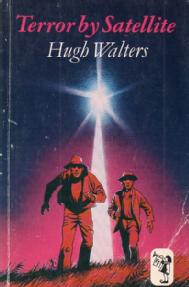 A less traditional approach to an electromagnetic weapon can be found in the novel Terror By Satellite by Hugh Walters (1964). This forms part of Walters’ series of juvenile novels featuring the early stages of space exploration by the United Nations Exploration Authority (UNEXA). Here the first orbital space station is primarily a civilian facility, with its main purpose being as an astronomical observatory. However the personnel of the station are terrorised by its commander, a military officer called Hendricks. As gradually becomes clear, he has discovered a way to focus “cosmic radiation” onto the surface of Earth, resulting in scorched and barren brown streaks below the observatory’s orbital path. Since the station is in a polar orbit, with Earth turning below it, this potentially covers the whole planetary surface. While the nature of the radiation is left a little unclear, it appears to comprise high energy photons such as X- or gamma-rays, rather than high energy particles. Eventually Hendricks uses his device to insist on taking control of the planet below. It’s interesting to note that the eventual solution to this problem depends on a couple of amateur home radio enthusiasts: highlighting both the interest in novel technology amongst the population at the time the novel was written, and the vast gulf between the way it was experienced by most individuals (e.g. domestic radio) and how it was experienced by the principal characters of the novel (e.g. space stations and rockets).
A less traditional approach to an electromagnetic weapon can be found in the novel Terror By Satellite by Hugh Walters (1964). This forms part of Walters’ series of juvenile novels featuring the early stages of space exploration by the United Nations Exploration Authority (UNEXA). Here the first orbital space station is primarily a civilian facility, with its main purpose being as an astronomical observatory. However the personnel of the station are terrorised by its commander, a military officer called Hendricks. As gradually becomes clear, he has discovered a way to focus “cosmic radiation” onto the surface of Earth, resulting in scorched and barren brown streaks below the observatory’s orbital path. Since the station is in a polar orbit, with Earth turning below it, this potentially covers the whole planetary surface. While the nature of the radiation is left a little unclear, it appears to comprise high energy photons such as X- or gamma-rays, rather than high energy particles. Eventually Hendricks uses his device to insist on taking control of the planet below. It’s interesting to note that the eventual solution to this problem depends on a couple of amateur home radio enthusiasts: highlighting both the interest in novel technology amongst the population at the time the novel was written, and the vast gulf between the way it was experienced by most individuals (e.g. domestic radio) and how it was experienced by the principal characters of the novel (e.g. space stations and rockets).
Exotic Weaponry
Nuclear and electromagnetic weaponry aren’t the only threats that science fiction narratives have placed in Earth orbit.
An alternate form of attack-by-satellite can be found in a tie-in novel to television series Captain Scarlet and the Mysterons, published by John Theydon in 1967 (simply entitled Captain Scarlet, but sometimes labelled Spectrum File 1). Here a set of four orbital platforms, named Alpha, Gamma, Beta and Omega are designed for weather control to mitigate disasters and aid agriculture. However, as is almost inevitable in this series, they are co-opted by the alien Mysterons and their abilities are turned to destructive effect. Such weather control systems used as weapons were predicted by Heinlein in Space Cadet (and one was also based on the Moon in Doctor Who), and highlight the danger of intervening in what’s still a poorly-understood and complex system.
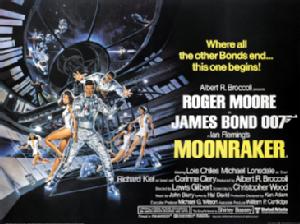 Also working on the atmosphere, the James Bond story Moonraker (film, 1979, dir. Gilbert) pivoted on the idea of a space station capable of deploying globes of nerve gas into the upper atmosphere. The villain of the story, Drax, plans to use a small group of “genetically-pure” young people preserved on the space station to repopulate Earth after humanity’s extinction. This form of chemical attack from orbit is perhaps less straightforward than some of the alternatives. Any weapons deployed from above the atmosphere might struggle to reach the ground given the various layers and currents in the upper atmosphere. Larger containers, or particles such as dust, might also be subject to burning up before they reach the ground. Capsules (or globes of gas) would have to be designed to survive reentry and then release their chemical contents when close to the ground. As such, an orbital launch platform makes for a fairly inefficient dispersal system - although as an excellent location from which to survive and observe the results of the attack.
Also working on the atmosphere, the James Bond story Moonraker (film, 1979, dir. Gilbert) pivoted on the idea of a space station capable of deploying globes of nerve gas into the upper atmosphere. The villain of the story, Drax, plans to use a small group of “genetically-pure” young people preserved on the space station to repopulate Earth after humanity’s extinction. This form of chemical attack from orbit is perhaps less straightforward than some of the alternatives. Any weapons deployed from above the atmosphere might struggle to reach the ground given the various layers and currents in the upper atmosphere. Larger containers, or particles such as dust, might also be subject to burning up before they reach the ground. Capsules (or globes of gas) would have to be designed to survive reentry and then release their chemical contents when close to the ground. As such, an orbital launch platform makes for a fairly inefficient dispersal system - although as an excellent location from which to survive and observe the results of the attack.
More recently, another weapons form has risen to prominence in popular awareness. So called “rods from god”, or kinetic weapons, do not have conventional explosive power. Instead they are inert masses dropped from orbit. In falling to Earth they achieve terminal velocity and the associated energy is released on impact with a blast comparable to that of a nuclear explosive. Such devices would be extremely difficult to aim with any accuracy, subject to atmospheric turbulence that would magnify even tiny errors in the initial orbital release. They have nonetheless been seriously considered for military deployment from space platforms (as in the proposed real-life Project Thor) and have since featured extensively in science fiction scenarios, including in the novels of Jerry Pournelle (who worked on these as a scientist) and Larry Niven (e.g. Footfall, novel 1985), thriller stories such as Don Pendleton’s Stony Man novel Orbital Velocity (2011), and in near-future-setting video games such as Call of Duty’s ODIN system.
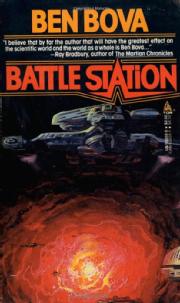 Kinetic weapons also appear in the writing of Ben Bova. Science fiction author and editor Bova frequently included orbital weapons technologies in his novels, and was an advocate of the strategic defence initiative in the 1980s. His short story collection Battle Station (1987) interspersed some of his short stories on the theme of militarised space with non-fictional writing. In its introduction he pointed out that military presence in space was a fact and an inevitability, that would have to be lived with, however undesirable it was deemed. The title story, “Battle Station”, imagines a network of nine battle control stations in Earth orbit, under the remit of the International Peacekeeping Force. These control a more extensive network of both high energy lasers and kinetic weapons in low Earth orbit, which are designed to set up a screen that will down any ballistic nuclear weapons. As in so many other stories of this kind, the system is subverted and comes under attack by extremists. In this case the antagonists are a group inspired by national pride in the United States and which rejects the movement towards international peacekeeping as a threat to their own superiority. To add to the tension, this group includes the son of the station commander.
Kinetic weapons also appear in the writing of Ben Bova. Science fiction author and editor Bova frequently included orbital weapons technologies in his novels, and was an advocate of the strategic defence initiative in the 1980s. His short story collection Battle Station (1987) interspersed some of his short stories on the theme of militarised space with non-fictional writing. In its introduction he pointed out that military presence in space was a fact and an inevitability, that would have to be lived with, however undesirable it was deemed. The title story, “Battle Station”, imagines a network of nine battle control stations in Earth orbit, under the remit of the International Peacekeeping Force. These control a more extensive network of both high energy lasers and kinetic weapons in low Earth orbit, which are designed to set up a screen that will down any ballistic nuclear weapons. As in so many other stories of this kind, the system is subverted and comes under attack by extremists. In this case the antagonists are a group inspired by national pride in the United States and which rejects the movement towards international peacekeeping as a threat to their own superiority. To add to the tension, this group includes the son of the station commander.
Turning further towards the futuristic, we encounter particle accelerator weapons. A good example here can be found in the Babylon 5 universe. Here the network of unmanned Aegis orbital defence platforms were designed as a last line of defence to protect Earth against alien aggression. Armed with both missiles and a powerful particle beam, they were turned on Earth itself during a climactic sequence towards the end of the fourth season of the television series (episode “Endgame”,1997). While the Aegis platforms were destroyed during this incident, and despite the established danger presented to the Earth below, the interstellar threat was considered sufficiently real that the system was rebuilt in the interval between this and one of the later television movies set in the same fictional universe (A Call to Arms, 1999). It’s worth noting that this particle beam, as well as the light-based weaponry mentioned above, would be highly susceptible to energy losses in Earth’s atmosphere. On the other hand, since the system is designed to obliterate a substantial chunk of a continent in one shot, perhaps dumping waste heat into the atmosphere (with its own destructive effects) would not be considered a significant problem.
Hanging Overhead
As the numerous examples listed above all illustrate, orbital weapons platforms can - in theory at least - present a serious threat to a planet-bound population. This basic truth lies behind the speculative designs of the WWII German sun-gun, and behind Project Thor and other concepts explored as part of the US Strategic Defence Initiative (a.k.a. The “Star Wars” programme) and its predecessors and successors. In a twentieth-century world reeling from first one world war and then a second, not to mention many ongoing conflicts around the world at any one time, it appeared unimaginable that any weapon that could produce such a decisive power advantage would not be developed and deployed. This is reflected in the near-certainty of 1960s writers that nuclear orbital platforms were a feature of future life.
In this context, it’s perhaps surprising that the UN Outer Space Treaty (signed by all the major powers in 1967 [4]) and developments to it under the aegis of the UN Committee on the Peaceful Uses of Outer Space (COPUOS) explicitly ban the use of space for military purposes. Two of the Outer Space Treaty’s key principles are that: “States shall not place nuclear weapons or other weapons of mass destruction in orbit or on celestial bodies or station them in outer space in any other manner” and “the Moon and other celestial bodies shall be used exclusively for peaceful purposes.”
Viewed optimistically, this speaks to human goals and aspirations for space. Viewed cynically, it’s likely that after the expense of the lunar Space Race, neither the US nor the USSR were keen to invest the vast sums that would be required for development of orbital platforms. Given the huge surface-based nuclear arsenal that had already been developed by that point, it’s also worth noting that orbital platforms were largely rendered unnecessary: existing weapons could readily destroy humanity and render the planet uninhabitable without the need for costly space developments. It’s also notable that, despite the Outer Space Treaty, space has been extensively used for military purposes in the years since it was signed, particularly for surveillance and military communications, and that deployment of space weapons has been official policy of various governments at times (notably during the US Strategic Defence Initiative era of the 1980s). The treaty is notoriously ineffective and lacking in any true consequences for malefactors. In other words, it’s likely that the failure of orbital weapons to fulfil the potential seen for them in science fiction is more to do with cost and practicality than any reluctance on the part of the military to deploy them.
However another aspect of these narratives, beyond the basic threat-of-death storylines, is worth considering. In a large number of examples, the threat is not described as coming from the weapons of enemies, but instead from the misuse of “friendly” weapons. Here weapons intended for defence - whether against other nations or against alien species - are turned on the humans they are intended to protect. This speaks to several running themes in science fiction. Examples such as The Tomorrow People’s Doomsday Men hint at the long running ethical debate about the interaction between scientists (capable of creating ever more destructive weaponry) and the military (who are trained to be willing to use it). As in "The Doomsday Men" (and, Ben Bova’s Battle Station, and indeed, in the tradition of the classic satirical film Dr Strangelove, 1964), a focus on military objectives and martial superiority is shown as conflicting with the best interests of the race. Science fiction asks whether scientist weapon developers have an obligation to consider such issues, or whether they can be safely deferred to others, such as soldiers or politicians, with differing training and priorities. Examples such as as the Bond films and Babylon 5 also highlight the dangers when such world-shaking powers are concentrated in the hands of any one individual, whether through wealth, political authority or criminal influences.
Interestingly enough, in none of the cases mentioned here are orbital weapons actually deployed against an enemy in a conventional war between nation states as political entities. I may well have missed some cold war examples of such conflicts in science fiction, but these are not the narratives that stick in the mind. Instead we see here a narrative of the misuse of power and the corruption of individuals rather than states.
Other examples, such as Star Trek (and to a lesser extent Babylon 5), perhaps ask a subtly different question. In imagining weapons platforms turned back on their homeworlds, they are asking whether not just the military but the race as a whole has the maturity and wisdom to manage such weapons, and whether taking them into a wider space domain is justified in the first place. By comparing humanity with both more and less advanced, and more and less peaceful, alien races, such series put the species into a broader context. They question how humanity might react if planetary defence on the scale imagined through the use of orbital weapons is actually required, and whether we could meet such challenges if we were faced by them.
In each case, whether explicitly or implicitly, these narratives return to the original premise of the Sword of Damocles story. In envying the king his power and luxury, the mythical Damocles was granted the same, but only at the cost of living with the fear and threat of death that accompanies it. Narratives of space weaponry remind us that the luxuries of the technological world in which we live (and particularly the advances of modern sciences in the 1950s and 60s) are direct consequences of the military-industrial complexes that helped fund and inspire much of their development. They ask whether attaining those luxuries was worth the threat of annihilation that was inextricable from that development. While such questions have perhaps faded from the public consciousness since the end of the Cold War, and as the result of the peacetime computer revolution, they have never entirely vanished. Such stories serve as a useful reminder that the luxuries we now enjoy may well be accompanied by existential, cultural or personal threats of their own. Like a space weapons platform, these can hang over us, unseen and, perhaps for the moment, disregarded, but bringing with them a substantive threat. Just to take one example, our current satellite-dependent world is increasingly vulnerable to the consequences of a space junk cascade event - whether triggered by orbital nukes as in Ken McLeod’s The Sky Road, or simply through inattention and a lack of regulation.
It’s undoubtedly something of a relief that the threat of a nuclear-armed space station never came to fruition. While it’s unlikely the speculative fiction of the era had any particular sway in this decision, it nonetheless served as an avenue to inform and motivate public awareness of the issue. More recent science fictional narratives of space weaponry, while less popular in recent years, continue to pose the same challenges both to the public and to the scientists and engineers who would be involved in the development of any such system. With space systems increasingly autonomous, and increasingly hard to monitor amidst the crowded near-Earth environment, individual weapons rather than space stations may loom over the next generation. The story of Damocles, and the price he paid for a life of luxury, remains relevant to this day.
“Swords of Damocles”, Elizabeth Stanway, Cosmic Stories blog. 25th February 2024
Notes:
[1] The Moon is, of course, a natural satellite in Earth orbit, and is frequently used as an attack platform in science fiction. For the sake of brevity, I’m going to set aside Moon-based lunar attack platforms here, although many of the same arguments apply and I might come back to these on another occasion. [Return to text]
[2] An honorary mention goes here to the 1960 movie adaptation of H G Wells’ The Time Machine. In a sequence set during the late 1960s, we see the advent of a third world war, and a brief mention is made of “nuclear satellites” getting into position. However, it’s not clear whether these are for armaments or surveillance, whether they are defensive or aggressive, or what role they play in the subsequent war. [Return to text]
[3] In fact the “Assignment Earth” episode of Star Trek was originally designed as a pilot for a completely different science fiction series, which was never commissioned or produced. This somewhat explains its focus on its one-off appearance characters rather than the recurrent cast, and slightly different style to more normal Star Trek episodes. [Return to text]
[4] Treaty on Principles Governing the Activities of States in the Exploration and Use of Outer Space, including the Moon and Other Celestial Bodies. [Return to text]
Comments are always welcome. The opinions expressed here are those of the author and do not necessarily reflect those of the University of Warwick. Images here are sourced online and used for commentary and criticism.

